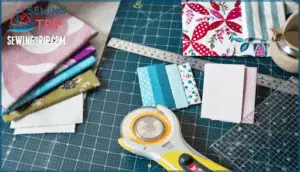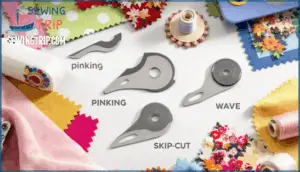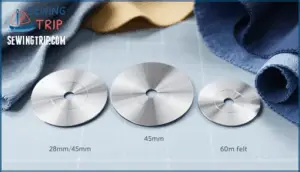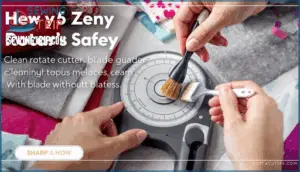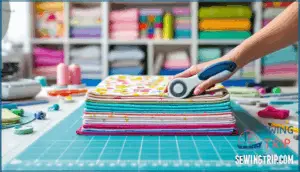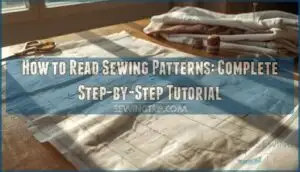This site is supported by our readers. We may earn a commission, at no cost to you, if you purchase through links.

Most quilters grab whatever rotary cutter they own and wonder why their cuts feel awkward or imprecise. The truth is, matching your blade diameter to your project type transforms cutting from a chore into smooth, controlled motion.
Whether you’re piecing intricate curves, trimming quilt blocks, or powering through batting and multiple fabric layers, the right blade size gives you control, speed, and clean edges without the fight.
Table Of Contents
Key Takeaways
- Blade size directly determines cutting control and efficiency—18mm and 28mm excel at tight curves and appliqué with 40% better accuracy, 45mm handles 80% of everyday quilting tasks through four cotton layers, and 60mm powers through six-plus layers with 25% time savings on long straight cuts.
- Matching blade diameter to your fabric type and layer count prevents frustration and extends blade life—lightweight fabrics under 50 GSM need 18-28mm blades, quilting cottons work best with 45mm, and heavy materials over 250 GSM require 60mm blades to cut cleanly without drag.
- Keep separate blades for fabric and paper projects because paper dulls fabric-cutting edges dramatically faster, and always replace blades every 8-10 hours of active use or when you notice skipped threads and uneven edges.
- Safety habits matter as much as blade choice—always retract the blade when not cutting, use cut-resistant gloves on your non-cutting hand, and dispose of dull blades in puncture-proof containers to protect yourself and others.
What Size Rotary Cutter Blade Do You Need?
Picking the right rotary cutter blade size makes the difference between smooth, accurate cuts and a frustrating wrestling match with your fabric. The size you need depends on what you’re cutting, how many layers you’re working with, and whether you’re tackling tight curves or long straight lines.
Let’s break down the four standard sizes and how to match them to your projects.
Overview of Rotary Cutter Blade Sizes (18mm, 28mm, 45mm, 60mm)
Think of rotary cutter blades like shoes—you wouldn’t wear stilettos to hike a mountain, and you won’t want an 18 mm blade to slice through six layers of denim. Rotary cutter sizes range from 18 mm to 60 mm, each with its own ideal use.
Choose your rotary cutter blade like shoes for terrain—18mm for curves, 45mm for everyday quilting, 60mm for thick layers
The 18 mm is best for delicate curves, 28 mm suits small projects, 45 mm covers everyday quilting, and 60 mm powers through heavy-duty cuts with ease.
Matching Blade Size to Project Type (quilting, Garment Sewing, Crafts)
Once you know the range, the next step is matching that blade to what you’re actually making—and that’s where quilting, garment sewing, and crafts each ask for something different.
- Quilting: The 45 mm accommodates most quilting blade size needs, cutting fabric for quilting through multiple layers with ease
- Garment sewing: A 28 mm excels at cutting curves and shapes along pattern lines
- Crafts: An 18 mm gives you control for intricate work
- Project complexity: Heavier fabrics or straight cuts? Go 60 mm
How Blade Size Affects Cutting Precision and Efficiency
Choosing rotary cutter sizes isn’t just about what fits your hand—it directly shapes your cutting precision and efficiency. Smaller blades like the 28 mm deliver up to 40% better accuracy on tight curves, making them ideal for curve cutting and appliqué work. Meanwhile, a 60 mm blade saves you up to 25% of your time on long, straight cuts and boosts layer capacity to six fabrics at once.
Blade longevity also varies: larger diameters outlast smaller ones by 15–20% on heavy jobs. User control improves with the right match, reducing fatigue and overcutting mistakes.
Always use a rotary cutter safely to prevent accidents.
Choosing The Best Blade for Your Project
Picking the right blade size isn’t guesswork—it’s about matching the tool to the task at hand. Different projects call for different blades, from tight curves to cutting through six layers at once.
Let’s break down which blade works best for each situation.
18mm and 28mm Blades for Small and Curved Cuts
When delicate curves and intricate details call your name, an 18mm or 28mm blade becomes your best friend at the cutting table. These smaller blade sizes give you the control you need for precision work that larger blades just can’t manage.
Here’s where they shine:
- Applique cutting around tiny shapes and detailed designs
- Template work with plastic guides for accurate pattern pieces
- Fussy cutting specific motifs from printed fabrics
- Clothing patterns with curved seams and intricate corners
The 18mm works beautifully for tight curves and mini quilts, while the 28mm offers slightly more stability when cutting curved pieces without sacrificing maneuverability.
45mm Blades for Everyday Quilting and Sewing
The 45mm blade is the workhorse of any quilter’s toolkit, addressing about 80% of your cutting tasks with ease. It cuts cleanly through up to four cotton layers at once—perfect for rotary cutters tackling general sewing and quilting projects.
You’ll reach for this blade size when squaring up blocks, trimming half-square triangles, or slicing strips from yardage. Its adaptable applications and solid blade longevity make it the go-to choice for cutting fabric day in and day out.
60mm Blades for Heavy-Duty and Multi-Layer Cutting
If you regularly cut thick fabrics like corduroy or power through six-plus layers of cotton at a time, a 60mm blade will save your hands and speed up your work. The larger size manages multiple layers smoothly and excels at long, straight cuts across fabric width.
You’ll especially appreciate the ergonomic grips on 60mm rotary cutters when trimming fully quilted projects or working on large-scale cutting sessions.
Specialty Blades (pinking, Wave, Skip-cut) and Their Uses
Beyond straight and standard cuts, specialty blades add unique decorative edges and functional finishes that you won’t get from a traditional rotary cutter.
Pinking blades prevent fabric fraying and add a zigzag edge to quilting projects, while wave blades are ideal for scrapbooking and creating ruffled fabric effects. Skip-cut blades produce dashed lines perfect for weaving or appliqué work.
These decorative edge cutting options represented 23% of rotary cutter blade sales in 2024, showing their growing popularity among crafters.
Key Factors When Selecting Blade Size
Picking the right blade size isn’t just about the cutter itself—it’s about matching the tool to your fabric, your hands, and what you’re actually cutting.
The fabric you’re working with, how many layers you need to cut through, and whether you’re following curves or straight lines all play a role in which blade works best.
Let’s look at the main factors that’ll help you choose the right size for your next project.
Type and Thickness of Fabric
Your fabric type and material thickness should drive your blade choice. Think of it this way: matching blade pressure to fabric GSM prevents material distortion and extends blade lifespan.
- Lightweight fabrics (35–50 GSM, like silk or chiffon) cut cleanly with 18mm or 28mm blades, reducing fraying by up to 40%.
- Quilting cottons (130–250 GSM) work best with 45mm blades for cutting fabric layers up to four thick.
- Heavy materials (denim, wool, fleece above 250 GSM) need 60mm blades to slice through thick fabric without drag.
- Specialty materials (leather, vinyl, cork) over 1.5mm thick require fresh 60mm blades for clean edges when cutting thick materials.
For peak performance, consider that Olfa blades are a popular choice for sewers.
Number of Fabric Layers to Cut
Layer count matters more than you think—it directly affects cutting quality and safety. Your 45mm rotary cutter manages 4 to 6 fabric layers smoothly, while a 60mm rotary cutter powers through 8 to 12 layers when cutting fabric layers for strip quilting.
Smaller blades work best with 1 to 2 layers for precision work. Blade size impact on efficiency is clear: matching your rotary cutter to project layer recommendations prevents fabric shifting and maintains clean edges.
Project Complexity: Curves Vs. Straight Lines
Curves demand maneuverability that straight cuts simply don’t. Your 28 mm blade navigates tight curves with minimal error—tests show 2.7 times fewer mistakes than using a 45 mm blade on curves. Straight efficiency peaks with larger blades: 45 mm and 60 mm blades cut straight lines 80% faster than smaller options. Blade control improves dramatically when you match size to task—switching between blades for curves and straight lines reduces overall error rates by 22%, following current project trends that prioritize precision over convenience.
- Cutting curves with 18mm or 28mm blades reduces fabric waste by 38%
- 45 mm blade is suitable for everyday straight cuts for 68% of quilters
- 60 mm blade powers through long straight cuts with 27% less wrist fatigue
- Mixed projects benefit from blade switching—19% less rework time
- Error rates drop 40% when students match blade size to cut complexity
Comfort, Hand Size, and Ergonomics
Your hand size and grip strength matter more than you might think when you’re cutting through yards of fabric every week. A 60 mm rotary cutter grip fits larger hands better, while 28 mm sizes suit smaller hands.
Cutter weight and ergonomic design directly affect hand fatigue—proper blade control reduces wrist strain by 30%. Test different rotary cutter selection options before committing to one size.
Rotary Cutter Blade Safety and Maintenance
A sharp rotary cutter makes your work easier, but only if you use it safely and keep it in good shape. Small habits like retracting the blade and cleaning away lint can prevent accidents and extend your tool’s life.
Here’s what you need to know to stay safe and keep your cutter working smoothly.
Safe Handling and Storage Practices
A sharp blade is only as safe as the habits you build around it—and rotary cutters demand respect from the moment you pick one up. Always keep the blade retracted when you’re not actively cutting, and use the locking mechanism if your cutter has one.
Cut away from your body, never toward it, and keep fingers well away from the cutting edge.
When you’re done, secure storage matters—store your cutter with the blade shield in place, out of reach of children and pets.
Using Safety Guards and Gloves
Even with good habits, your hands deserve an extra layer of protection—especially when you’re cutting multiple layers or working with a brand-new blade. Rotary Cutter Safety Gloves add injury prevention where it counts most:
- Cut-resistant glove material protects your non-cutting hand
- Built-in blade shield blocks accidental contact during blade changes
- Guard types vary—some cutters include retractable shields, others use snap-on covers
- Safe storage means keeping guards in place between projects
- Blade disposal containers prevent cuts during cleanup
Safety precautions don’t slow you down—they keep you working confidently.
When and How to Replace Rotary Cutter Blades
Once your blade starts dragging through fabric instead of gliding, it’s time for a swap—and knowing when to make that change keeps your cuts clean and your fingers safer.
Replace your rotary cutter blade every 8–10 hours of active cutting, or sooner if you notice skipped threads or uneven edges. Quick-change cutters simplify blade replacement—just follow your manufacturer’s instructions.
Always dispose of used blades in puncture-proof containers to prevent accidents.
Cleaning and Maintaining Your Rotary Cutter
Keeping your rotary cutter clean isn’t just about tidiness—it’s about preventing dull blades and sticky, uneven cuts that slow down every project. A clean blade moves smoothly, maintaining sharpness longer.
Wipe the nut and shield weekly to remove fabric dust that can gum up blade rotation.
Store your cutter with the blade retracted in a dry spot to prevent rust and keep safe storage habits second nature.
Tips for Optimizing Cutting Results
Getting the right blade is only part of the equation—how you use it matters just as much. A few simple practices can make your cuts cleaner, your blades last longer, and your projects go more smoothly.
Here’s what makes the biggest difference in your cutting results.
Using Cutting Mats and Rulers (e.g., Creative Grids Stripology XL)
Think of your cutting mat and ruler as the unsung heroes behind every clean, straight cut—they’re what turn a sharp blade into precision magic. A self-healing mat protects your 45 mm rotary cutter blade while providing clear cutting angles guide markings.
Press your ruler firmly to prevent shifting—stability matters more than pressure when slicing through layers. Quality quilting tools extend mat longevity and keep your rotary cutters performing their best.
Keeping Blades Sharp and Well-Maintained
Nothing dulls a blade faster than fabric lint, thread bits, and the stubborn grit that sneaks between your cutter’s layers—so regular cleaning isn’t optional, it’s essential. Unscrew the nut, wipe down the blade and safety shield, then reassemble for instant blade sharpness improvement.
Proper rotary cutter maintenance and storage solutions prevent rust and extend blade life. When sharpening techniques won’t revive performance, safe blade disposal protects everyone using your tools.
Separating Blades for Fabric and Paper Projects
Paper dulls fabric blades faster than you’d ever imagine—one session cutting cardstock or freezer paper can leave your once-glorious edge struggling through cotton like it’s cutting through sandpaper. That’s why smart sewers keep separate rotary cutter blades:
- Label your blade storage boxes "fabric only" and "paper/templates"
- Choose tungsten blade material for paper—it better addresses project contamination
- Switch blades before cutting fabric to maintain blade longevity
- Use dedicated cutting surface mats for each material type
- Mark blade grips with colored tape to prevent mix-ups
Efficient Blade Rotation and Disposal
Your rotary cutter blade doesn’t need to go straight to the trash the moment it struggles with fabric—a smart rotation system can squeeze months of extra life from each blade while keeping your cuts clean and safe.
Here’s how blade rotation extends blade lifespan:
| Stage | Best Use | Rotation Frequency |
|---|---|---|
| Sharp (new) | Precise fabric cutting | Every 8-12 hours use |
| Semi-dull | Paper templates, batting | After fabric struggles |
| Dull | Disposal or recycling | When skipping threads |
Professional sharpening techniques rarely match new blade performance.
For safe disposal, wrap old rotary cutter blades in cardboard and tape securely, or use blade recycling options through craft stores. This blade replacement procedure protects you and sanitation workers while maximizing your blade maintenance investment.
Frequently Asked Questions (FAQs)
What is the difference between a rotary cutter and a circle cutter?
Standard rotary cutters use freehand cutting with circular blades (like 45 mm or 60 mm) for straight lines and curves.
Circle cutters lock into a pivot point for cutting perfect circular shapes with blade design focused on precision arcs, not general fabric work.
What is the best rotary cutter for beginners?
A 45 mm rotary cutter with safety features and an ergonomic design is ideal for beginners.
Look for models with easy blade changes and budget options that include starter kits for quilting projects.
How do I know when it’s time to change my rotary cutter blade?
If you notice fabric snagging issues, frayed edges, or skipped spots during cutting, it’s time for blade replacement. A dull blade requires extra pressure and damages your cutting mat.
Regular rotary cutter blade replacement maintains blade sharpness and guarantees clean cuts.
What are the different types of rotary cutter blades?
Many quilters don’t realize rotary cutter blades go beyond sizes—blade materials, coatings, and specialty blade designs matter too. Standard cutting blades use stainless steel, while premium options feature titanium carbide blade coatings for extended blade sharpness.
Specialty blades include pinking, wave, and skip-cut styles. Grip ergonomics and blade replacement ease vary by brand.
How do I care for my rotary cutter blade?
To keep replacement blades cutting smoothly, wipe them clean after each project to remove fabric dust and lint. Store your rotary cutter with the blade retracted or covered for rust prevention and safe disposal preparation. Replace dull blades promptly—maintaining rotary cutters properly guarantees clean cuts every time.
Can rotary cutter blades be sharpened at home?
Yes, you can sharpen rotary cutter blades at home using DIY sharpening methods like aluminum foil or fine-grit sandpaper. However, replacement blades are usually more cost-effective and guarantee cleaner cuts than maintaining worn blades.
Are rotary cutter blades universal across brands?
Blade dimensions and arbor size aren’t universal—it’s like expecting every puzzle piece to fit every box. Brand compatibility varies because manufacturers use different locking mechanisms and shaft designs.
Always check replacement blades match your rotary cutter’s specifications, though adapter options sometimes bridge the gap.
How long does a rotary cutter blade typically last?
It depends on blade material, fabric type, and cutting frequency. High-quality stainless steel cutting blades can last months with proper care, but heavy use or thick fabrics require replacement blades sooner. Sharpness retention also depends on storage impact and the blade replacement procedure you follow.
What causes rotary cutter blades to dull quickly?
Like a sharp knife meeting sandpaper, certain conditions accelerate blade wear. Cutting paper dulls cutting blades fast—fabric type matters since thicker materials strain blade material and construction.
Poor cutting mat quality, excessive cutting pressure applied, and improper blade storage methods all shorten lifespan before blade replacement procedure becomes necessary.
Conclusion
Pinpoint precision starts with pairing the proper blade to your project. Now that you know what size rotary cutter blade you need, you can skip the frustration and cut with confidence.
Match small blades to curves, reach for your 45mm workhorse for everyday tasks, and let the 60mm power through thick layers. Your choice determines whether you’ll wrestle your fabric or glide through it cleanly every time.
- https://www.nationalquilterscircle.com/post/what-to-look-for-in-a-rotary-cutter
- https://suzyquilts.com/quilting-rotary-cutters-a-complete-guide/
- https://cottoncandyfabrics.blog/2025/04/02/which-rotary-cutter-is-right-for-your-project/
- https://ldhscissors.com/blogs/news/whats-the-difference-between-45mm-and-60mm-rotary-cutters
- https://madamsew.com/blogs/sewing-blog/choosing-a-rotary-cutter-size


